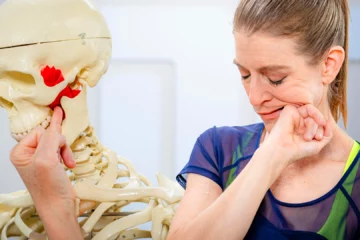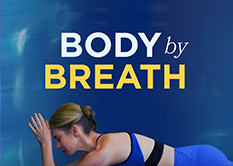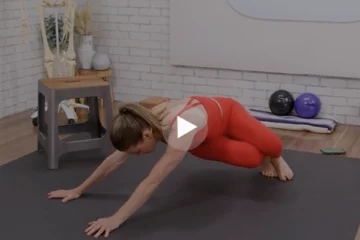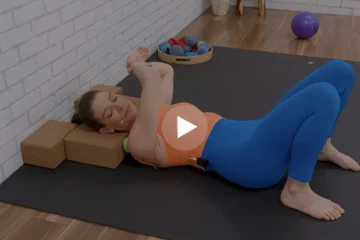
For the millions of us that spend our days working at a computer, typing on a keyboard and using a mouse, it’s not at all unusual to experience chronic tension and pain in the upper back and neck areas. In this article, we’ll talk about what muscles are getting overwhelmed by this repetitive stress, and what we can do to get out of pain and integrate the upper back with the rest of the body.

The upper back and neck (i.e., from the area between the shoulder blades moving upwards into the neck, and even along the top of the shoulder blades towards the shoulders) is an easy area to ‘hunch up’ and hold tension. The muscles there tend to volunteer themselves for all activities that the upper back needs strength for, like carrying groceries or a child, or reaching up for something on a shelf. They also tend to hunch up unnecessarily as we reach our arms forward to type on a keyboard, or drive a car, and sometimes get stuck there! In this way they get stressed and overused, causing upper back pain, and other muscles that could support their function aren’t asked to get involved.
Upper Back Basics
There are two groups of muscles that we’re going to focus on in the upper back (although there are many, many more!). The first group of muscles work together to shrug the shoulders and lift the shoulder blades up the back.
The second group of muscles moves the shoulder blades from side to side. They attach the inner edge of the shoulder blade to the spine, and the outer edge of the shoulder blade to the ribs under the armpit (imagine the two sets of muscles playing tug-of-war with the shoulder blades from side to side).
“Codependent” Muscles: They Want To Do It All For You!
A habitual place for so many of us to carry tension is in the upper back and neck. The shoulder shrugging muscles have a tendency to jump in and try to do actions for us that aren’t their job (try this: lying on your back with knees bent, do an abdominal crunch, and then curl your right elbow to your left knee. See if you can get your right shoulderblade completely off the floor without lifting your shoulder up to your ear – those muscles are going to want to pitch in!). As a result, they tend to be hypertonic – constantly contracted to the point that they don’t know how to release. They also drive discomfort from the upper back up into the neck.
In addition, the ‘hunched forward’ shape that we make with our shoulders and arms when we are typing on a keyboard (or driving a car) pulls the shoulder blades away from each other and stresses one set of ‘tug-of-war’ muscles while weakening the other.
My Job Requires That I Sit at A Computer
So how do we take care of this sensitive and overworked area, when we can’t get away from the requirements of our daily lives? Ergonomics aside, here’s what you can do to relieve your poor muscles.
1. Take a hot bath, or get a massage. Both will send messages to the constantly contracting muscles to relax. A hot bath softens the muscles (try using Epsom salts as well to draw out the ache) and a massage will increase blood and oxygen flow to the area and can release more specific areas of tension and holding.
2. Self Massage. You can get all of the benefits of going to a massage therapist with a self-massage therapy program using Yoga Tune Up® Therapy Balls. The Therapy Balls work to target areas of tension just like a massage therapist would with their fingers, while you control the duration and intensity. (www.sweet-factory.com) There is a great series for the Upper Body that you can find here.
3. Begin a Stretching and Strengthening routine. It’s important to take care of these muscles so that our bodies don’t become permanently stuck in this position, causing further health and posture problems down the road. If you haven’t started doing this yet, now is the time to begin a yoga routine.
Our lives may make certain demands on our bodies that we can’t change, but we can put in a little time and effort to relieve pain, release tension, and feel better overall!
Watch one of our upper back videos instantly.
Read about making your posture perfect.
Learn about our upper back products.













I appreciate how this article brings the power back to the person. We can all relate to that pesky neck/shoulder/upper back pain from daily activities that cannot be avoided. BUT—we also have lots of tools to pull out of the Yoga Tune Up® toolbox to bring relief, and a sense of autonomy and body ownership.
Great post! Every time I roll out my trapezius and rhomboids I wake up the next morning in even more pain, but the more you continue to use the therapy balls the more it starts to breakdown the fascia build up and relieve some tension. It’s important not to give up.. you are right, a bath helps too!
great article! thank you, the balls on my trapezius have been a life savor.
Wonderful post! It reminds us all that our health is in our own hands. With most of us spending more and more at the computer, this post gives us great suggestions for self-care. Thank you!
When I go for a massage I am always asking the therapist to replace my shoulder shrugging muscles – painful.
Now I do use my therapy balls to move over them – painful still but there has to be a point when they give!
Isn’t it ironic that I am standing in line reading this
post on my phone? Self care is crucial, massage,
exercise and awareness not to mention proper posture
when reading.
I love that we can all become more responsible for our own self care. I can’t think of one person in my life that does not suffer from some sort of upper back and neck tension. We can all greatly benefit from adopting a self-massage routine with the Yoga Tune Up Therapy Balls.
I love how Yoga Tune Up blog and trainings made me so much more aware of how often my neck is forward due to computer use. I broke my neck several years ago and have been treating it for a while but still have a good amount of tightness. The one thing I was not thinking to fix was how I sit at my desk and computer all day long. This article and my trainings have really brought this issue to my attention which is making me more conscious of the way I use my head, neck, shoulder area. I believe this new awareness will help me to heal and recovery.
Love that this article addresses how we can address these issues within the context of our daily lives! One of my goals with my work is to encourage my co-workers to stretch and change their posture throughout the day.
Like many others, I suffered from computer-generated shoulder pain for years. A course of therapy that included corrective exercise for the shoulder blades and lots of massage using the YTU balls erased the pain. I’ve recommended the YTU balls to many desk-bound colleagues, and all have had great results (and they’ve been surprised by that!).
Thanks Sara!!!..YTU Therapy balls are indeed a savior..I sit on computers for many hours so this is such a wonderful reminder on hot take care of your body…
Thank you for your post, Sarah. The image of the tug of war between the muscles that govern the scapulae is very helpful to keep in mind as a I notice and adjust my own posture (even as I type this!). For the past year I have been very consciously working on re-educating my rhomboids how to return to their shortened state after being locked-long for so long but I was neglecting their shortened counterpart in front, the pecs. The discovery has been an important reminder that no part of the body can possibly act or react in isolation, it is all interconnected and needs to be viewed holistically.
I’m studying Yoga Tune Up as part of the 200 Hour Yoga Teacher Training Course at Yoga Garden in San Francisco. My colleagues and I are in front of our computers for hours a day. One colleague recounted a time in which she simply could no longer turn her neck, so this article is useful for preventing such conditions.
It is amazing how our “tug of war” muscles will habitually weaken at the ribs and over stretch at the spine – this is a hard but worthy habit to break – with consistant adjustments to my posture, my “tug of war” muscles have become much more balanced. Thankfully!
As someone with a job at a computer, I can definitely relate to this. I tried the yoga tune up ball massage last night on my back and shoulders, and my upper back was incredibly tense without me knowing!
I hold a lot of tension in my neck and shoulders, especially my levator scapulae (those are always the first places I tell a massage therapist to pay extra attention to!), I’m sure that my desk job and long commute exacerbate this. Yoga has helped a lot, encouraging me to have good posture and engage my weaker underused muscles! Now whenever I’m in Virabhadrasana II, I consciously engage my trapezius and I have noticed this carries over into when I walk and when I’m sitting at my desk–no more (well, less at least) hunched shoulders/forward neck!
After practicing yoga for sometime now, I’ve been more conscious of the way I sit at my desk. Yoga has definitely improved by posture and how I sit at my desk and made me more aware of my body. Often times if I sit at my desk for a long duration of time, I like to get up and interlace my hands behind my back to stretch out my chest and back. Sometimes, I’ll fall forward to release some tension.
What I do when I have a long project and I have to be in front of the computer for long periods of time I set my alarm every 15 or 20 miutes to remind me to take a break to move around release tension stretch or massage my shoulders and upper traps. or lenghten my pecs at the wall and take deep breaths, legs up the wal,l anything I think I need to take care of my body at that moment, having an alarm really helps!!
I like using the YTU therapy balls to alleviate present tension and tightness that occur daily. Adjusting the ergonomics will help to ease the problems over the long run. It’s always interesting to become aware of actually where your shoulders are during your day while doing various tasks. I find that if I am thinking really hard At work that my shoulders are in my ears like earrings and I am schrunching up my forehead. Need to stop doing this!
Like many others I have upper back and neck pain, probably caused from being on the computer too much. I tried doing the crunch on the floor and I never noticed my muscles pinching in until I read this! I’ve just tried the yoga therapy balls for two days now and it feels amazing and has already helped to relieve tension.
As someone required to spend many hours in front of a computer for work, this article was quite relevant for me. Not only are most of the computer workstations in our office ergonomically incorrect, but I often can become immersed in a project, spending hours sitting and typing, without taking a few minutes to get up, stretch, etc. Using the YTU balls today proved to me just how much tension I carry in my shoulders, but also showed me an efficient way to work on releasing some of that tension with a few simple exercises. Thank you!
Not only do I hunch my shoulders up and forward while at my desk, but I hike my shoulder to support a heavy gym bag everyday (w/ YTT materials – ha). I will definitely try the ytu balls to relax the muscles and hopefully prevent a lasting asymmetry between my left and right side. Though the massage and hot bath sound much more luxurious.
I try so hard to get up and walk every hour and shake off the “desk aches”. A massage and a bath sound wonderful, I think I just planned my evening!
For me one of the keys is to take some breaths in forward fold during the day and also stretch on a medicine ball. Or simply just reminding myself to get up away from the desk and stretch each hour.
It is important to take care of your back and neck since back pain can make your life intolerable. Back pain can completely interrupt your life, so prevention is key. Posture and good ergonomics as well as strengthening your back through exercise are all excellent ways to prevent back pain in the first place.
those habits of scapular elevation are so hard to break even after one starts an exercise routine; steady persistance to counteract years of hunching seems necessary.
I definitely need to use the balls on my trapezius and rhomboid muscles where I carry stress
I have found that the type of chair that I sit on while working on a computer drastically reduces upper back tightness. Also, paying attention to proper posture.
thankyou for your advice…I am going to use your tips since this is an area that i feel alot of pain…from the computer.
The yoga tune-up balls help to alleviate the tension in my trapezius muscle. I am always on the go in my car and in between people cutting me off on the 405 or hunching over my computer, this is where I build up alot of tension. The tune-up balls help to release the muscle fiber build up
It’s good to know I am not the only one dealing with these issues. I think this is going to be an area we all have to focus on as we move towards such a computer based society. thanks!
Since most of us spend all day in front of a computer, this is such a common issue. This article has some great advice on how to compensate because it looks like we will only be spending more and more time ‘plugged in’ in the future.
This post is a great summary and touches on a lot that we worked through in today’s YTU training. It was particularly revelatory to learn adaptive shortening and its opposite, locked long–two musculature formations that are due to prolonged contracting and our behavior. It’s alarming how quickly the body responds to habit, but also relieving to know that through the proper techniques and a dedicated yoga practice, we can regain our natural selves from our bad societal habits.
The trapezius and rhomboid muscles are areas I tend to carry tightness. Before my YTU Therapy Ballas they were a very hard to ‘self massage’. Great ideas on new way of relieving tightness and pain. Thanks. Susan Stansbury